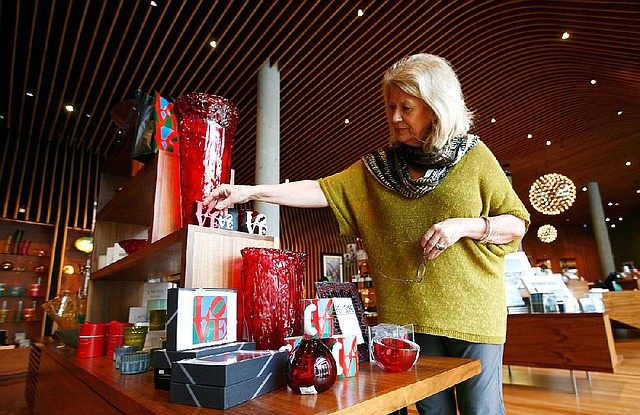Museum stores add dimension to bottom lines
Crystal Bridges gift shop took in $1.82 million in ’12
Mary Douthit, retail operations manager, organizes a display on Wednesday, Feb. 6, 2013, inside the museum store at Crystal Bridges Museum of American Art in Bentonville.
Sunday, February 24, 2013
BENTONVILLE — Running a for-profit gift shop in a nonprofit museum, though seemingly contradictory, produces revenue that goes hand in hand with the operation of Crystal Bridges Museum of American Art, said Mary Douthit, retail manager.
Museum-store sales are a litmus test, said Andrew Andoniadis of Portland, Ore.-based Andoniadis Retail Services, a consulting firm that has Crystal Bridges as one of its clients. If the store is not selling site-specific merchandise and establishing a link with visitors, it’s not fulfilling its role.
“Otherwise, it’s just like any other gift shop,” he said.
That’s what makes the job challenging, said Douthit, who joined Crystal Bridges in early January after holding key positions at the Art Institute of Chicago, Tiffany & Co. of Chicago and the Blanton Museum of Art at the University of Texas at Austin.
“We must be retail strategists, while educating and entertaining our guests with products that entice, arouse curiosity and reflect the museum experience,” she said.
Gross sales at the Crystal Bridges museum store for 2012 totaled $1.82 million, she said.
The median sales figure for stores in museums and related institutions in the United States in 2009 was $215,026, according to the website of the Denver-based Museum Store Association.
Twenty-nine percent of such stores generated more than $500,000 in gross revenue in 2009, the most recent data available. The numbers include stores in museums,botanical gardens, aquariums and zoos.
The Bentonville museum’s curvilinear retail space is a little more than 3,000 square feet. Its ceiling made with cherry-wood slats was inspired by baskets made by Northwest Arkansas artist Leon Niehaus who sells some of his creations in the store. Fayetteville-based design firm Marlon Blackwell Architect is the store’s designer. Blackwell designed the space to complement the museum’s natural setting and distinctive architecture, said Diane Carroll, media relations manager at Crystal Bridges.
Depending on the time of year, the museum store has between 2,000 and 3,000 items for sale. The best-seller is Celebrating the American Spirit, a catalog of the museum collection.
Crystal Bridges is the brainchild of Alice Walton, daughter of Wal-Mart Stores Inc. founder Sam Walton. It opened Nov. 11, 2011, and has had more than 680,000 visitors. The museum has considerable financial flexibility compared with other major institutions.
In 2010, the Walton Family Foundation, which is funded by Sam Walton’s heirs, gave more than $1.3 billion to help pay for the museum’s annual operations, acquisitions and capital upkeep, and to fund artwork and operating expenses. At the time, museum experts said the funding was perhaps the largest in history.
Admission to Crystal Bridges is free, but nationally 74.6 percent of the $8.8 billion generated in 2012 by museums came from admission fees,according to the Museums in the U.S. report by Los Angelesbased industry research firm IBISWorld. Sale of merchandise makes up 3.3 percent of total revenue, according to the report.
The Crystal Bridges retailing team is gearing up for American Chronicles: TheArt of Norman Rockwell, organized by the Norman Rockwell Museum in Stockbridge, Mass., and scheduled to open in mid-March.
The exhibit will have its own store, a first for the museum. Douthit said sales of merchandise related to the show are expected to be 10 percent of the store’s annual revenue for 2013.
Andoniadis said consumers are becoming used to“pop-up” stores that support traveling collections, and the stores are good revenue generators.
“We’ve been in contact with the Norman Rockwell Foundation and have done extensive planning,” said Pam Conway, assistant retail manager. “They’ve been very helpful and can tell us what people always want.”
Famous artists are the big retail draw, but original art byregional artists adds to the store’s attractiveness, Andoniadis said.
The store includes original art by regional artists such as Niehaus of Huntsville and Bill Koch of Jay, Okla. Douthit said sales of original art at the store make up about 10 percent of revenue.
Douthit makes it clear she’s enjoying her work.
“I feel like I landed in Heaven,” she said.
Business, Pages 67 on 02/24/2013
